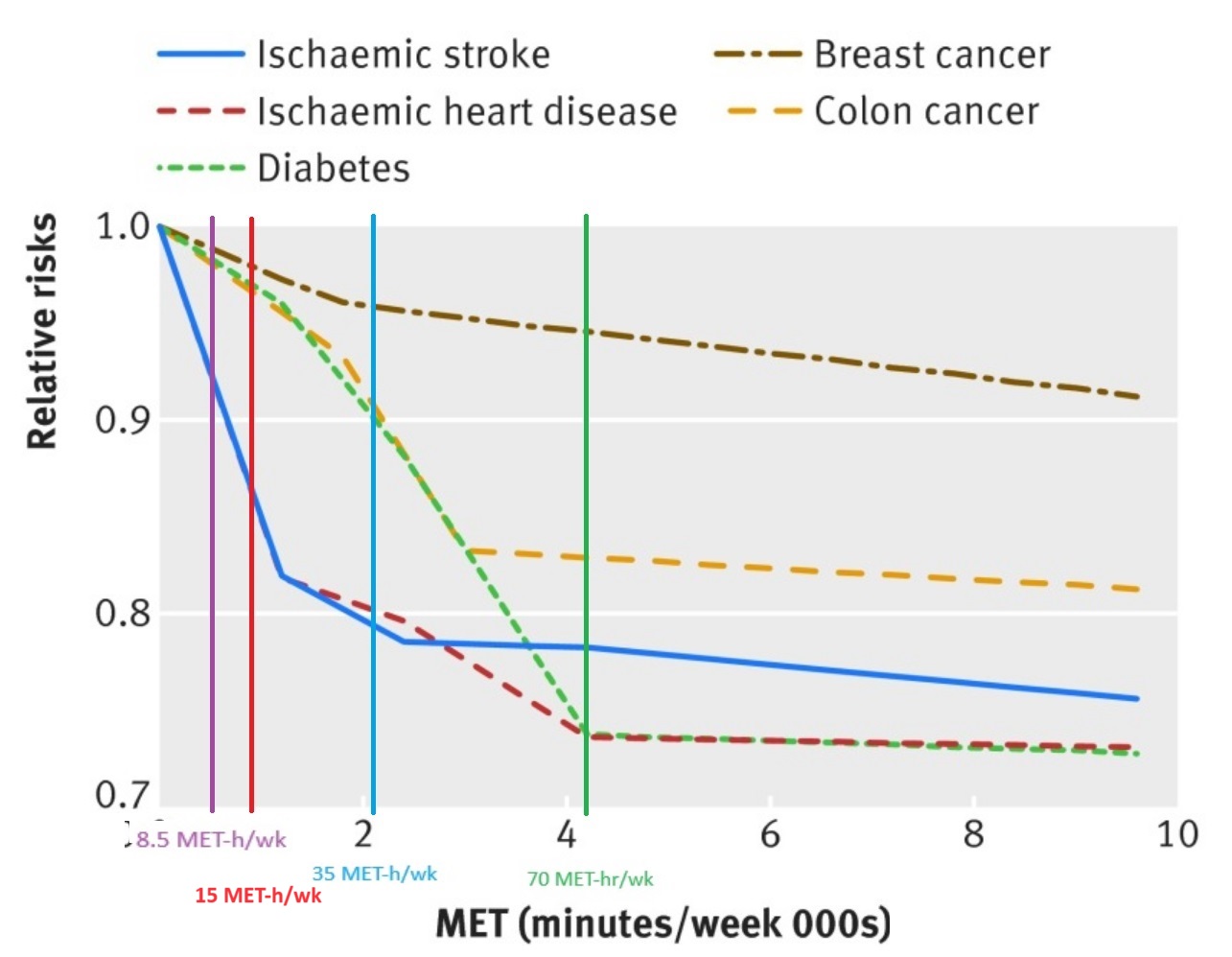How Much Exercise Do We Really Need?
Disclaimer: I am not a doctor. This is NOT medical advice. Please talk to your doctor before changing anything in your diet, exercise, lifestyle, or medications.
I enjoy exercise but spend at least 70 hours a week sitting in front of my computer. I wanted to answer the question, “I know exercise is important, and more is better, but what’s the minimum dose I should strive for?” Luckily, some research has been done on this:
This is a summary review of studies undertaken between 2006–2018. It’s looking at the relationship between exercise and mortality. If we define the “minimum exercise dose” as the amount significantly reducing the chance of an early death, then this research has our answer. They conclude that everyone should strive to reach the “2008 Physical Activity Guidelines for Americans.” These researchers are associated with the guidelines, but that is not necessarily bad. The guideline is one of:
- 150–300 minutes of moderate-intensity physical activity
- or 75–150 minutes of vigorous physical activity per week
- or an equivalent combination
I’ve seen numbers like this before, but what are the definitions, and how do I relate this to what I enjoy doing? A unit of measure called MET, or “metabolic equivalents of task,” is used to equate different types of exercise. Things like walking, bicycling, and swimming all have an equivalent MET score, which can be used to normalize the value of the activities.
If we assume 3.4 METs for moderate-intensity activity, then the 2008 guidelines of 150–300 minutes translate to 8.5–17 MET-h/wk as the minimum target. The optimal exercise target appears to be much higher, at about 70 MET-h/wk, equivalent to running 1–1.5 hours/day. Buried in the analysis is a reference to a 2016 study that identifies 35 MET-h/wk as the minimum dose to offset > 8 hours/day of sedentary activity (basically me).
Since we’ve reaffirmed that “more is better” regarding exercise, it’s hard to identify the correct minimum. We’ve got a range of 8.5–35 MET-h/wk, depending on which study you take stock in. Instead, the best approach might be to identify what you are doing and decide if you can adjust. Here’s my average activity (using MET estimates):
Resistance Training = 0.75 hrs x 3 times/week x 4 MET/h = 9 MET-h/wk
Elliptical Machine = 0.5 hrs x 2 times/week x 6 MET/h = 6 MET-h/wk
Total = 15 MET-h/wk
From the study, we can estimate the benefits:

How do we interpret this (the red line, 15 MET-h/wk)? I am getting significant cardiovascular benefits from my exercise routine, but if I want to reduce my diabetes risk to the same degree, then I need to increase my workload. My example equates to ~ 15% reduced risk of heart attack and stroke, ~ 3% reduced risk of diabetes and colon cancer, and ~ 2% reduced risk of breast cancer. If you look closer at the actual study data, there is a lot of noise in the numbers. These lines represent an average benefit and should be considered guidelines only.
Can’t I just count my steps? Sure, but let’s translate that to METs to estimate the benefit. Walking varies from 2.3 to 3.3 METs depending on your speed (1.7 to 3 mph). Let’s use 2.9 METs (2.5 mph). For me, there are about 2110 steps in a mile, so 5000 steps works out to about 2.75 MET-h, and if I did that every day, it would be 19 MET-h/wk. The power of movement!
Does the type of exercise matter? Yes, there are benefits to both low-intensity and high-intensity training. You should do a mix of both. In addition, as people get older, they start losing muscle mass. This is called Sarcopenia; you must lift weights and adjust your diet to offset this phenomenon. It can start happening as soon as age 40, and probably everyone over age 60 should be doing some resistance training.
A 2022 systematic review of sixteen studies found that muscle-strengthening activities were associated with a 10–17% lower risk of all-cause mortality, cardiovascular disease (CVD), total cancer, diabetes, and lung cancer.
Finally, the Copenhagen City Heart Study (CCHS) followed participants’ leisure time sports activities and tracked their health for 25 years (ending in 2017). It’s an observational study, meaning it does not show causation. Still, it suggests that people who played social sports had even longer life expectancies than those just exercising: Health club = +1.5 years extra life, Cycling = +3.7 years, Badminton = +6.2 years, Tennis = +9.7 years.
The message is clear, if you are not getting out and moving around then you need to start. The minimum dose is “do as much as you can.” Build a routine you can keep up with, and then estimate your MET-h/wk. Match it against your health goals and personal risk factors, and make more informed decisions about your health.
Dave DuBois
November 18, 2023